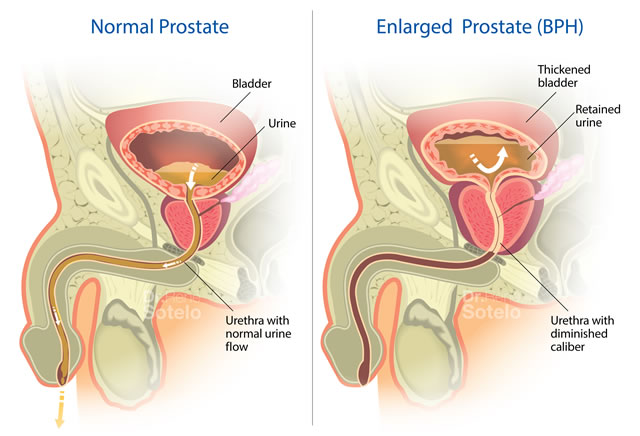Prostatic Hyperplasia
Causes and symptoms of prostatic enlargement
During the first two decades of a man’s life, the prostate gland grows steadily, reaching a size of approximately 20 cubic centimeters (1.22 cubic inches). Between the ages of 20 and 40, this growth ceases and resumes around the fifth decade of life. Thereafter, the gland will continue to grow. This process is known as benign prostatic hyperplasia (BPH) and although, as its name indicates, it is not related to prostate cancer, it can become a health problem, since there is a risk of it causing obstruction and difficulty in urinating. However, both the age at which this growth occurs and the size the prostate can reach vary from person to person.

In addition to age, other factors have been linked to prostate growth. Among them are alcoholism and liver cirrhosis, which are two conditions that increase the concentration of estrogen, a blood hormone that stimulates prostate growth. Likewise, family history can be another factor that indicates that there is a risk of benign prostatic hyperplasia, since the sons of patients who have presented this condition have a risk up to four times greater than other men of developing the disease. In many of these cases, BPH occurs at an early age (sometimes before the age of 50) and the gland can reach a large volume.
Benign prostatic enlargement has several possible causes:
It is due to androgens; mainly testosterone, which decreases with age, and dihydrotestosterone, which remains the same or increases with age. Estrogens, despite being one of the main female hormones, exist in low quantities in men and increase with age. These hormonal interactions apparently favor prostatic growth because they prevent the cell from dying and, by doing so, there is an increase in the number of cells.
On a microscopic level, the organization between the tissues, specifically the stroma-epithelium interaction, is altered and produces an excessive and progressive growth. This is enhanced and benefited by the growth factors —which are normally present—, going from normal levels to a progressive increase.
A correlation has been found between benign prostatic growth and specific genes, which indicates a greater probability of developing the pathology when it has already occurred in several men within a family.
One theory about benign prostate growth is that it is caused by an inflammatory process that is perpetuated over time and signaled by cytosines or cytokines, favoring the stimulation not only of cell growth, but also of their multiplication.
Science keeps advancing, and that is why every day more possible causes of prostatic hyperplasia are discovered, and this in turn allows the development of new therapies for its treatment. Thus, alterations in the signaling of nerve impulses, or in the RHO-kinase system, prolactin, oxygenation of the prostate, among others, have been found.
Patients with urinary discomfort
It is estimated that these difficulties, which affect the increase in prostate size, do not necessarily cause the same symptoms in all patients. It has been found that the appearance of urination difficulties does not correlate with the size of the prostate. That is to say, there are patients with many difficulties in urinating whose prostates do not show considerable growth, while others with a notable growth of the gland do not develop this problem.
In general, the symptoms of benign prostatic hyperplasia are thinning and weakness of the urinary stream, difficulty in starting to urinate, intermittent urination or dribbling at the end of urination.
There may also be an urgent or frequent need to urinate, increased urination during the night (nocturia) or the sensation that the bladder is not completely emptied when urination is finished.
There are several explanations for the triggering of these symptoms. One of them is that the prostatic capsule, which encases the gland like a shell, begins to compress the rest of the organ, causing an increase in pressure inside the prostate with consequent difficulty in urinating.



